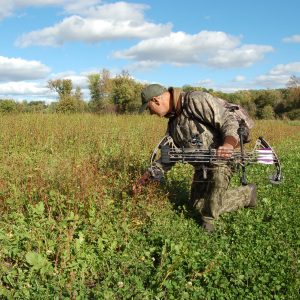Installing and using treestands safely revolve around the Law of Gravity, formulated by Isaac Newton (1642-1727). We know it by the simple saying, “What Goes Up, Must Come Down.” Consider the fact that falling from any height isn’t good for you.
Years ago, I recall hunters building homemade stands out of two-by-fours, plywood, and some long spikes. It was a good idea, but the materials were temporary as the elements would take its toll. Wood decayed, weakened and collapsed; nails rusted and broke, and often at the wrong time.
Decades of building treestands using modern manufacturing techniques and advanced materials have given us the quality stands available to us today.
The three most common stand types are the ladder stand, the climbing stand, and the hang-on stand. Each type has its advantages and disadvantages. The basic advantage of any tree stand is the ability to get above the vision range and scenting ability of game. The common and obvious disadvantage is falling.
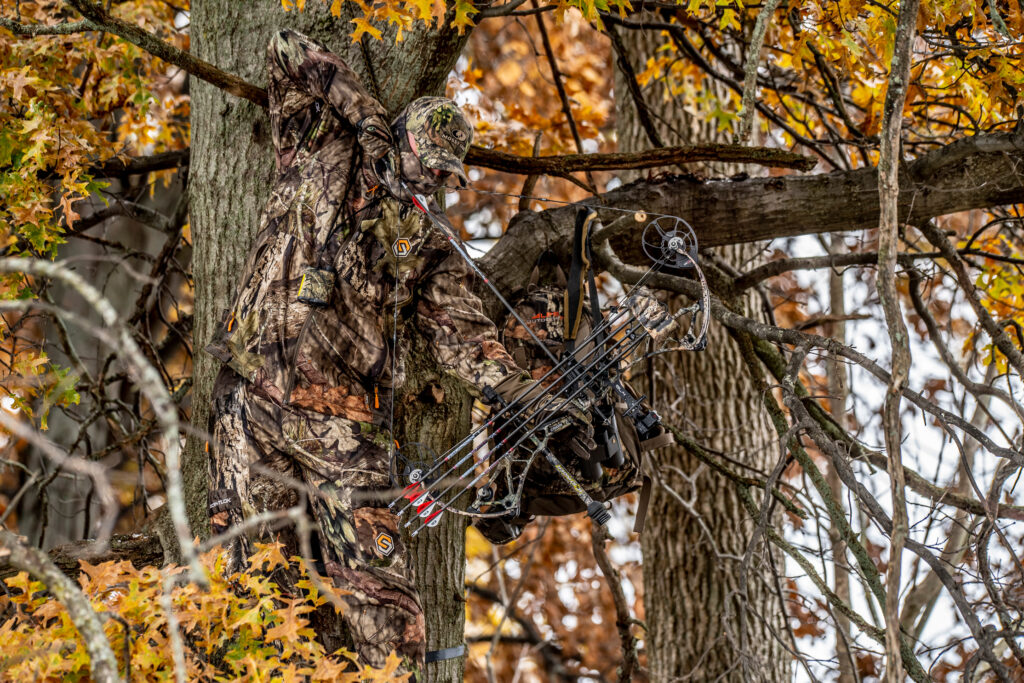
Before we get into the nitty-gritty of the types of stands and their safe use, let’s take a side road and talk about something that is needed for all types…the lifeline. The lifeline is a rope that can be used for each type of stand. This has a sliding knot known as the “Prusik knot.” The knot slides freely up or down. Putting tension on it causes it to grip the rope. You can purchase the lifeline with the knot or make your own. You can find the knot demonstrated online at Animated Knots. Don’t grip the Prusik knot while climbing or descending. If you fall the natural reaction is to grip the knot which will slide with you down to the ground much faster than you want.
Using Ladder Treestands Safely
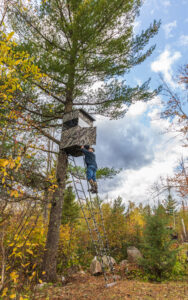 The ladder stand is easy to climb and get into. They come in various heights, giving the hunter a choice on how high is needed to gain an advantage over the game. A two seat ladder stand is a good way to introduce someone to hunting, talking with a quiet voice to instruct and answer questions. However, it is more difficult to set up, requiring two or three people mainly to help with the extra weight.
The ladder stand is easy to climb and get into. They come in various heights, giving the hunter a choice on how high is needed to gain an advantage over the game. A two seat ladder stand is a good way to introduce someone to hunting, talking with a quiet voice to instruct and answer questions. However, it is more difficult to set up, requiring two or three people mainly to help with the extra weight.
Again, the lifeline is used to ascend or descend the stand. This is secured to the tree when you set up the ladder stand. Yep, you must first set up the stand to attach the lifeline. As you climb, move the Prusik knot up while maintaining three points of contact with the ladder. You start out with two hands and two feet. Just keep three of the four on the ladder.
When ascending or descending the stand, the tether on your Fall Arrest System (FAS) or Full Body Harness (FBH) is attached to the Prusik knot. A fall will put tension on the Prusik knot and stop your fall.
Using Climbing Treestands Safely
The climbing tree stand is considered by some to be the easiest to use. One hunter can attach it to the tree and use a climbing sequence not unlike the lineman’s crawl. Make sure the tree is straight with no limbs to interfere with your ascent. If it appears dead or has slick bark, look for another tree.
Two things need to be mentioned here. First, if the climbing stand doesn’t have a tether to hold the top and bottom sections together, make one. A close friend got to his chosen place to set up. Slowly climbing to his desired height, he watched in horror and dismay as the bottom ratcheted down the tree 22 feet below him. Fortunately, it was late fall. He had lots of clothes and a short piece of rope he used to climb down. What was worse, his hunting partner was silently watching this whole scene, stifling his laughter!
Second, “Physics 101” comes into play with the climbing tree stand. Some make it a practice to bounce on the bottom part to seat-it on the tree trunk. OK, let’s say your stand is rated at two-hundred fifty pounds. With two cups of coffee, a three egg omelet, two slices of toast with jelly, two buttermilk pancakes and your clothes, gear, bow or firearm, you tip the scales at two-hundred twenty pounds. Yep, this is under the recommended weight rating. So far, so good. But when you bounce on the bottom part of the climbing tree stand, you are multiplying the weight by fifty percent! The tree stand now is subjected to three-hundred and thirty pounds! What will happen? After reading this, I’ll bet you can guess. Follow the recommended rating and don’t bounce. Simple, isn’t it?
Using Lock-On Treestands Safely
The third type is the hang-on tree stand, also called a lock-on tree stand. This type is a bit more involved, requiring some extra steps to hang it properly. Setting it in place is done in three stages. First, the lineman’s rope is secured up to allow the hunter to hang the second climbing stick or next few tree-steps. The lifeline is also looped around the tree. The tether on your fall arrest system or body harness is attached to the Prusik knot on the lifeline.
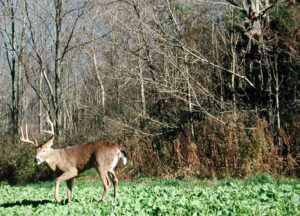
Charles Alsheimer
Secure the first climbing stick so the first step is easily reached. Remember, if you have lots of clothing, your ability to bend your leg will be limited. Secure and carefully test the step and begin your climb. The top of the first stick and the bottom of the next stick should be the same distance as from the ground to the first step or about twenty-four inches. As you climb higher, move the lineman’s belt and the lifeline. How high do you want to climb? Is there anything that interferes with your desired height for the stand?
Keeping the lineman’s rope and lifeline secured, hang the stand, taking care to keep your balance. When the stand is in place and secure, step down onto the stand. That’s right! Step DOWN onto the stand – make that step the easiest of the climb. Stepping up will shift your center of gravity backward which can throw you off balance. Not a good thing.
Attach the tree strap to the tree, attach the safety harness tether to the tree strap and remove the lineman’s rope. The tether should have very little slack when you are seated.
Use a haul line to pull your unloaded firearm or bow up to the stand. Basically, climbing with firearms, backpack, bow, etc. is dangerous or could be downright deadly! Falling across a rifle or shotgun could result in a broken back or worse. Climbing with a bow is just as dangerous. Consider how razor sharp broadheads perform on wild game.
Two additional things are necessary here. First, have a plan to recover to the stand if you should fall. The tether attached to the tree should keep you near the stand so you can maneuver your way back into the stand. Second, have a “suspension relief loop” attached to your safety harness; this can also double as a “deer-drag.”
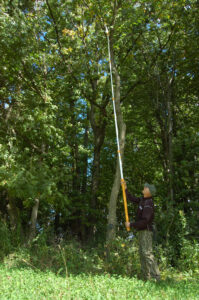 Why the suspension relief loop? If you can’t get back onto the tree stand, you might be suspended for a time. Suspension trauma can be deadly. This is where the blood pools in the lower extremities, resulting in a shortage of blood to the brain and vital organs. An example is a military formation where someone passes out because of standing in one place for a long time. This also happens at weddings that take a long time. One of the wedding party passes out. Same cause and result. A friend knows of two hunters who died as a result of suspension trauma. The harness and loop allow you to put a foot into the loop and stand up. You can try to get back into the stand or descend to the ground. There are devices that allow you to descend in a controlled manner. A search on the internet should give needed information.
Why the suspension relief loop? If you can’t get back onto the tree stand, you might be suspended for a time. Suspension trauma can be deadly. This is where the blood pools in the lower extremities, resulting in a shortage of blood to the brain and vital organs. An example is a military formation where someone passes out because of standing in one place for a long time. This also happens at weddings that take a long time. One of the wedding party passes out. Same cause and result. A friend knows of two hunters who died as a result of suspension trauma. The harness and loop allow you to put a foot into the loop and stand up. You can try to get back into the stand or descend to the ground. There are devices that allow you to descend in a controlled manner. A search on the internet should give needed information.
Your tree stand should come with a harness or vest-type safety harness. As previously stated, this can be called a “fall arrest system” or full body harness. Same thing, but called by two different names.
I have an instructor in my Hunter Education class who has a unique way of demonstrating the use of these items. He has some young volunteers come to the front of the class. He gives each one a harness or vest. He has the lights turned off and tells the volunteers to put on the harness. His point is to show that it is more than likely going to be 0-dark thirty when we get to the hunting area. It might be possible to wear some types while driving to your hunting spot. Basically, practice putting on the FAS or FBH before hunting
A story regarding the use of the FAS or FBH should be told. An avid hunter in a northeastern state got into his tree stand. This time he didn’t put on his FAS or FBH. The one and only time! He fell and injured his back. He also suffered serious head trauma resulting from the fall, resulting in a stroke. He has the use of only his left arm which controls his wheelchair.
The Tennessee Wildlife Resources Agency sends a booklet of statistics to all instructors, summarizing each accident that occurred during hunting season. The period of 2010-2015 shows there were nine fatal accidents involving tree stands. Eight were a direct result of failure to wear a Full Body Harness/Fall Arrest. The ninth resulted in not maintaining a tight line attaching the FBH/FAS to the tree. The victim fell and the harness became wrapped around his neck. Each one could have been prevented by following simple rules. In 2009, Mississippi made FAS/FBH use mandatory for hunting on Wildlife Management Areas. Hopefully, other states will follow this regulation.
You have arrived at your chosen spot. The ladder stand is in place with help of friends who are hunting in another area. Or, you have set up your climbing stand and are ready to get in position, overlooking the game trail, food plot, etc. Or, you have attached the climbing sticks and have secured your hang on stand. What’s next?
No matter what type of tree stand you have, read ALL the instructions! Pay attention to the warning notes or comments in the instruction manual. Again…no matter what type of tree stand you have, read ALL the instructions! Pay attention to the warning notes or comments in the instruction manual. Look at the expiration date.

Inspect all fasteners, hinges, cables, straps for wear, damage or being loose. Check any place the stand is welded and make sure there are no cracks, indicating a weak joint. A close friend went to inspect his ladder stand a few days before deer season. Someone cut the straps so that just a few threads were holding it in place. Climbing would have broken the straps, causing him to fall.
Leave instructions to let someone to know the place where you are hunting, and the time you’ll be entering and leaving the area. Do this even if you’re hunting multiple places that may depend on wind direction, game movement, or time of day. When scouting or setting up, make sure your cell phone will have a signal to make a call.
Spending a few bucks for something like SPOT, might be worthwhile if you hunt in an isolated area like the western states. This is not an endorsement but a suggestion to consider this or something similar.
Last, but not least, check for the TMA (Treestand Manufacturer’s Association) logo to show that the treestand has been tested and approved. You can go to www.tmastands.com for more information plus the website has an interactive video and quiz on tree stands.


